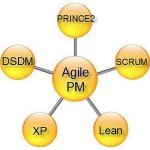Agile PM Adoption – The Challenges and the Steps
 Traditional project delivery has similar principles and practices with the agile project management (PM) methodology. Both approaches aim to deliver measurable results in timely manner. Agile PM adoption – or a transition from the traditional project delivery approach to the agile project methodology – becomes a quite predictable and manageable activity that can be accurately planned in a sequence of simple steps taken before any actual development process takes place.
Traditional project delivery has similar principles and practices with the agile project management (PM) methodology. Both approaches aim to deliver measurable results in timely manner. Agile PM adoption – or a transition from the traditional project delivery approach to the agile project methodology – becomes a quite predictable and manageable activity that can be accurately planned in a sequence of simple steps taken before any actual development process takes place.
However, having no idea of how to adopt the agile project management methodology to current project practice can make you feel frustrated and confused. Before making any decisions you need to get expert advice on this point. Also attending some PM training courses will be helpful for you. And reading through online a books and articles will be the minimum you’ll need to get an idea of the adoption.
Challenges
This article is written to point out key challenges that you may face when trying to adopt the agile PM methodology to current project practice. By successfully handling the challenges you are enabled to reinforce the agile PM adoption and create a productive work environment. We ranked the challenges for agile implementation by several key levels, from the management level to the team level.
Let’s view the challenges for agile project methodology adoption.
- Management Level.
Senior management and executives involved in your project are those people who should show commitment to agile PM adoption and provide support to further agile implementation. While the traditional approach requires managers to work within predictable environments and encourage the extensive time commitment, agile-based PM requires senior management to be focused on the delivery of value to the customer.
It also accepts the intensive level of team collaboration, organize daily stand-up meetings, and accept the reality of agile project management uncertainty and abstain from arbitrary work schedules and budgets. - Team Level.
The core tenet of agile PM adoption is the requirement for highly skilled team members. The agile PM methodology requires teams to be small, and each team member should be a highly motivated and well-trained person able to handle special challenges of working in an agile project environment, be ready to work in a highly transparent environment, show personal creativity and diligence, and focus on achieving team goals. - Customer Level.
While following the traditional PM approach the customer and other stakeholders are able to control the scope of project by monitoring cost estimates and staff assignments, the transition to using the agile project management tools will inevitably deprive the customer of the traditional signposts of project progress. When the new approach is adopted, the customer suffers from changes in their own workload and faces the need for integrating into agile project management teams.
Steps
These levels of the challenges for agile PM adoption can be successfully handled through following a few steps. These are Agile Project Management Training, Assess of project Team Readiness and Analysis of Project Portfolio. Let’s view each of the steps.
- Provide PM Training.
Before moving to the agile work environment, it’s important to senior management and team leaders to learn about agile frameworks and agile terminology. The best way to do it is through organizing special training based on iterations. Visit certification websites, such as the Agile Alliance and the Project Management Institute (PMI). - Assess Team Readiness.
The next step is to assess the team readiness to participate in agile-based projects. There’re several key criteriafor assessing the team readiness:- Ability to make quick and independent decisions.
- Commitment to work as a collaborative group.
- Ability to solve problems and come up with new ideas.
- Knowledge and experience with using agile project management tools and software for producing project results.
- Analyze Project Portfolio.
Because the agile project management methodology is best for innovative projects, senior management and team leaders should analyze the project portfolio and select projects that can be managed with the agile approaches while the rest projects will be best suited for traditional project management frameworks.
For the last several years, agile PM adoption has grown and developed even regardless of the innovative frameworks the methodology offers. Today there’s no question that agile project management methods can be applied successfully to a broad range of project initiatives. Teams, customers and stakeholders can use agile project management tools to benefit from making a collaborative effort focused on the project vision and the end result.














